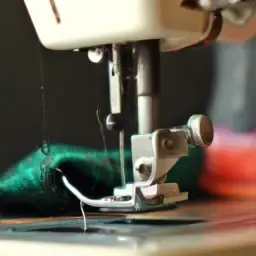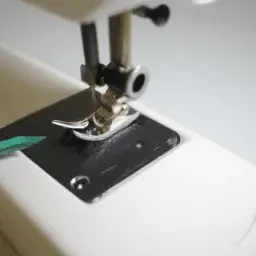This site is supported by our readers. We may earn a commission, at no cost to you, if you purchase through links.
Sewing machines have become an essential tool for anyone interested in designing and creating their own clothing or accessories. They have revolutionized the textile industry and have made it much easier to create intricate designs in a shorter amount of time. But how does a sewing machine work? In this article, we’ll take a closer look at the inner workings of a sewing machine and explore the different types available in the market.
Table Of Contents
The Basics
At its core, a sewing machine is a device that uses a needle and thread to stitch fabric together. The machine works by using a motor to power a series of mechanisms that control the movement of the needle and the fabric. The needle moves up and down, while the fabric is guided through the machine by a set of feed dogs.
Types of Sewing Machines
There are different types of sewing machines available in the market, each designed with a specific purpose in mind. Some of the most popular types of sewing machines include:
Mechanical Sewing Machines
Mechanical sewing machines are the most basic type of sewing machine available. They are operated by a foot pedal and require the user to manually adjust the tension and stitch length. These machines are perfect for beginners and those who are looking for a simple machine to complete basic sewing tasks.
Electronic Sewing Machines
Electronic sewing machines are more advanced than mechanical machines. They are equipped with a motor that powers the machine and allows the user to adjust the stitch length and tension with the push of a button. These machines are perfect for intermediate sewers who are looking for more advanced features.
Computerized Sewing Machines
Computerized sewing machines are the most advanced type of sewing machine available. They are equipped with a microprocessor that controls the machine’s operations, including stitch length, tension, and speed. These machines are perfect for advanced sewers who are looking for a machine that can handle complex designs and patterns.
The Components of a Sewing Machine
A sewing machine is made up of several components that work together to create a stitch. These components include:
Needle
The needle is the part of the machine that punctures the fabric and creates a hole for the thread to pass through.
Bobbin
The bobbin is a small spool that holds the thread and is located underneath the needle plate.
Feed Dogs
The feed dogs are a series of metal teeth that move the fabric through the machine.
Tension Control
The tension control is a mechanism that controls the amount of tension on the thread as it passes through the machine.
Stitch Length Control
The stitch length control is a mechanism that controls the length of the stitch.
How Does a Sewing Machine Work?
Now that we’ve explored the different types of sewing machines and the components that make up a sewing machine, let’s take a closer look at how a sewing machine works.
Step 1: Threading the Machine
The first step in using a sewing machine is threading the machine. This involves winding the thread onto the spool pin, threading the thread through the tension control, and then through the needle.
Step 2: Bobbin Winding
The next step is to wind the bobbin. This involves placing the thread onto the bobbin winder and winding the thread onto the bobbin.
Step 3: Inserting the Bobbin
Once the bobbin is wound, it is inserted into the bobbin case and placed under the needle plate.
Step 4: Sewing
The final step is to start sewing. This involves pressing the foot pedal to power the machine and guiding the fabric through the machine while the needle creates stitches.
Common Sewing Machine Problems
While sewing machines are designed to be reliable and efficient, they can sometimes experience problems. Some of the most common sewing machine problems include:
Thread Breakage
Thread breakage can occur if the tension on the thread is too high or if the needle is dull.
Skipped Stitches
Skipped stitches can occur if the needle is bent or if the needle is the wrong size for the fabric.
Jamming
Jamming can occur if the thread is not properly wound or if the machine is not properly lubricated.
Conclusion
Sewing machines have revolutionized the way we create clothing and accessories. By understanding how a sewing machine works and the different types available, you can choose the best machine for your needs. With a little practice and patience, you can create beautiful and intricate designs that will last a lifetime.
Frequently Asked Questions (FAQs)
Q How often should I clean my sewing machine?
It is recommended to clean your sewing machine after every use to ensure that it continues to function properly.
Q Can I use any type of thread in my sewing machine?
No, it is important to use the correct type and weight of thread for your sewing machine to ensure that it functions properly.
Q How do I know if my sewing machine needs to be serviced?
If your sewing machine is making unusual noises or is not functioning properly, it may be time to have it serviced by a professional.
Q Can I sew through multiple layers of fabric with my sewing machine?
Yes, most sewing machines are designed to handle multiple layers of fabric, but it is important to use the correct needle and thread for the job.
Q Do I need to oil my sewing machine?
Yes, it is important to oil your sewing machine regularly to ensure that it continues to function properly. Refer to the manufacturer’s instructions for specific oiling requirements.









